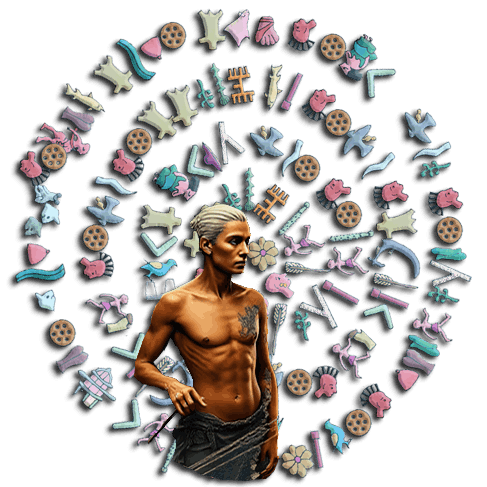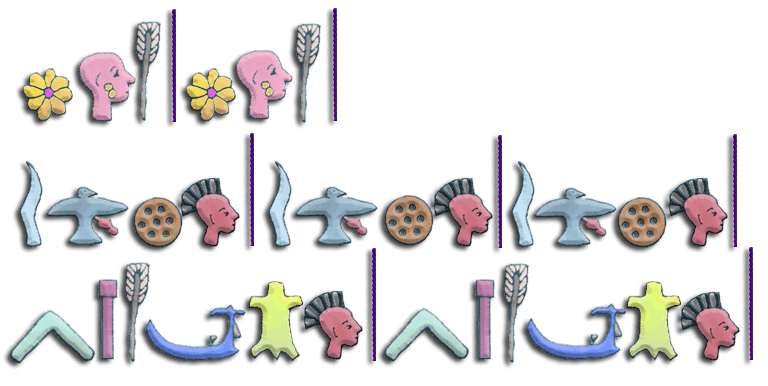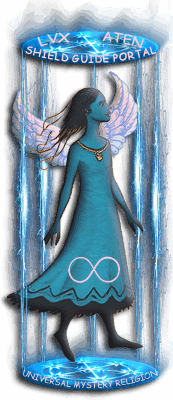























































































































|
It is easy to see how a visionary artist familiar with this ancient science of Containment of Geometrical Arrangements could envision the creation of a disk with other familiar forms - the boat, the star, the pyramid - and not just the natural geometrical arrangements (geometry) that would occur by connecting with lines the matching distributed pictographs on the disk. None of the pictographs are randomly placed on the Phaistos Disk. If the pictographs were hieroglyphs, as so many linguists are hoping for, then the ability to communicate additional pictographs would be lost because the pictographs would need to form sentences and could not therefore be precisely placed to form images.
Information about this ancient world would be completely lost in time because, in order to recall it, we would need to be able to speak or decipher the script. If we could not, then all would be lost. But a simple method of connecting familiar pictographs with lines would leave us able to comprehend their world because we would be able to see and understand the pictures without having to know the dead language, the idea being that geometry is universal, the stars are eternal, and the Great Pyramid is permanent. This Phaistos Disk method of transmitting information is brilliant.
A pictograph is an ideogram, conveying its meaning through what it resembles, unlike hieroglyphs that tell a story using alphabetic composition. Where hieroglyphs gain meaning by successive placement of the glyphs and represent words, pictographs gain meaning by selective grouping of the signs and convey ideas by what they resemble. Where script is a language that can be deciphered and read involving speech sounds, a pictograph is a symbol complete within itself representing an object or an idea.

These disk pictographs, for example, are what they seem to resemble; a pig, ?, an axe, water, ?, a fish, and a crab. What other meanings can they have? Grouped together this way they seem to be ideograms representing parts of a wide-spread ancient Egyptian mythology well-known to the Minoans and the Aegean world - the Isis-Osiris mythology. In this set, when Osiris's evil brother Typhon was out hunting pigs, he found the body of Osiris, that he had originally tossed into the Nile inside a coffin-chest, and chopped it into pieces with his axe, then threw it into the Nile River where one of the pieces, the phallus, was eaten by the sharp-snout fish and the Nile crab.
In the case of the Phaistos Disk the locations of the pictographs are specific placeholders to anchor images and/or geometries that create even larger pictographs conveying even larger ideas. In this respect, the Phaistos Disk displays an advanced, well-thought-out system of picture writing.
Picture writing potentially can convey much more information about a civilization than a script can because it shows both the archetypal or universally understood elements of any civilization and also the elements of a specific civilization. Picture writing speaks to everyone, and this makes it a better method of communication than script for many reasons. Script is abstract and has to be learned, making script writing a part of the social, financial and political fabric of a civilization.
Not everyone can understand script, but everyone can interpret picture writing. When one of the pictographs is deciphered or identified, then something about the civilization is deciphered or identified, and from this can come much information about the people, about how they lived, what they believed in, and how they expressed it. Arrange the pictographs differently and they mean something different. Place them in certain geometrical arrangements and, again, the meaning changes.
Although the Phaistos Disk does not display a hieroglyphic narrative, this Bronze Age, pottery art masterpiece might record an ancient mythology, story or event by use of the narrative technique "continuous representation," the depiction of successive incidents or scenes within a single composition by artists telling a story with their art. It began in Mesopotamia and was fully developed in Minoan Crete in their mosaics.
The disk seems to be a fantastic example of continuous representation in art but instead of several successive scenes as in the Maze of Daedalus there are successive pictographs or ideograms. In some instances, groups of pictographs and even line segments are exactly repeated or continuously represented, indicating a careful selection on the part of the artist(s) in using certain pictographs to anchor certain images and geometries in order to create continuous representation. This would afford additional meaning for this brilliant picture writing language. These line sequences are repeated - continously represented - on the Phaistos Disk.

"Narrative art is art that tells a story, either as a moment in an ongoing story or as a sequence of events unfolding over time. Some of the earliest evidence of human art suggests that people told stories with pictures. However, without some knowledge of the story being told it is very hard to read ancient pictures because they are not organized in a systematic way like words on a page, but rather can unfold in many different directions at once." (Wikipedia - "Narrative Art")
 Copyright Notice - Disk of the World - Text and images copyrighted March 21, 1993-2025, Claire Grace Watson, B.A., M.S.T., U.S. Copyright and under the Digital Millennium Copyright Act of 1998, All rights reserved. No part of this web page may be reproduced or transmitted in any form or by any means without written permission from the author, except for the inclusion of brief quotations in a review.
Copyright Notice - Disk of the World - Text and images copyrighted March 21, 1993-2025, Claire Grace Watson, B.A., M.S.T., U.S. Copyright and under the Digital Millennium Copyright Act of 1998, All rights reserved. No part of this web page may be reproduced or transmitted in any form or by any means without written permission from the author, except for the inclusion of brief quotations in a review.